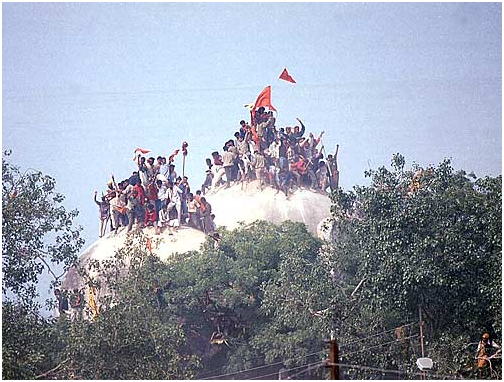Babri Mosque: Ram Temple and Communal Agenda

23 Years and the Fight Goes On
NEW DELHI: The demolition of the Babri masjid December 6, 1992 was a major attack on India’s secular foundation. The demolition was a well planned act presided over by the Sangh Parivar. Prime Minister Narasimha Rao of Congress played the role of backroom assistant. The demolition was followed by massive communal violence in Mumbai-Surat-Bhopal.
Interestingly most of the accused got away scot free. Some cases are still on but unlikely to yield results. And many emerged politically stronger.
The Liberhan Commission appointed to enquire into the demolition, took decades to submit its report for reasons best known to the presiding judge. Most of the leaders at whom the Liberhan Commission pointed a finger continue to be active and assertive in politics. The consequent communal violence has been the major factor leading to polarization along religious lines. The demolition unleashed divisive trends and it will not be an exaggeration to state that the Ram temple movement and Babri demolition strengthened the BJP as a strong political player in the country.
The cases regarding the ownership of land dragged in the courts for a long time. On September 30, 2010, the Lucknow bench of High Court gave its verdict trifurcating Babri Masjid land among the Sunni Central Waqf Board, Nirmohi Akhara and Ramlalla. In this judgment the faith of people was one of the directing factors. The different parties in the case were not satisfied and appealed to the Supreme Court, where matters are pending and it is unlikely that an early decision will come forth. There is also talk now of overcoming the legal tangle by making a law in the parliament to build the temple. However, with its current strength in Parliament, the BJP cannot push such a law.
Meanwhile immediately after the Court verdict RSS chief Mohan Bhagwat called upon the Muslims to give up their claims to the land and respect the feelings of the majority community. Bhagwat is now articulating his hope that the Ram Temple will be built in his lifetime.
In our country the real issues relate to bread butter, shelter, employment and dignity-human rights. For communal organizations the path to power is through emotive issues and so they want to focus on these time and over again. We have also seen that for communal agenda, centralization of power and bypassing of the real life issues of average people is their method of political games. The emotive issues help them electorally. The Ram Temple has been regularly used for electoral purpose, now again it is being propped up.
Recently when Vishwa Hindu Parishad leader Ashok Singhal died the entire Sangh Parivar paid tributes to him for his association with temple movement. He was deputed by the RSS to work for the VHP in the 1980s and after his coming into the fold of the VHP; the agitation was intensified. It was from this point on that BJP, with L.K.Advani in the lead, also took this up and made it a political issue. It is this issue which in a way went on to be the major cause of communal violence in times to come. Babri demolition was a major assault by the Sangh Parivar on the Indian Constitution.
The BJP did come to power with Ram Temple on its lips, but having been in power for nearly six years it paid a lip service to the temple construction. Now again it has been in power and the temple issue has been a big weapon to intimidate the minorities and spread falsehoods about history. The whole campaign in a way demonstrates the well coordinated RSS progeny, different wings doing their share of damage to the fabric of India, to the idea of India.


